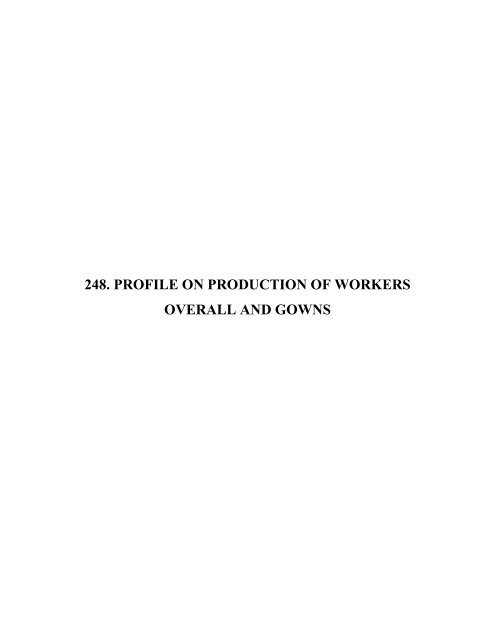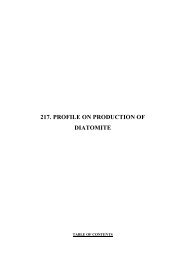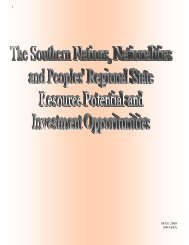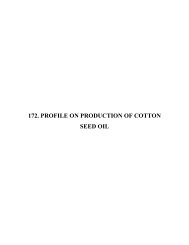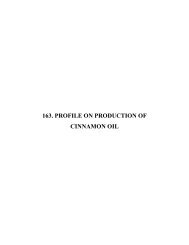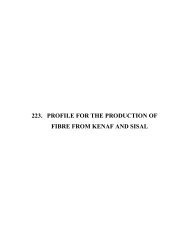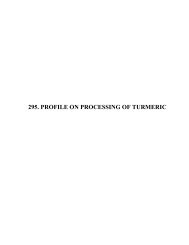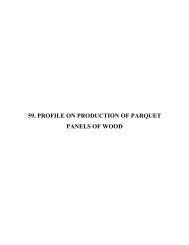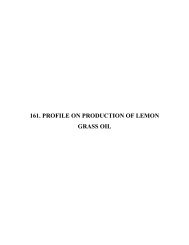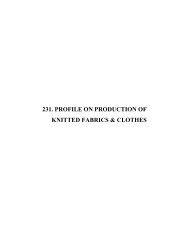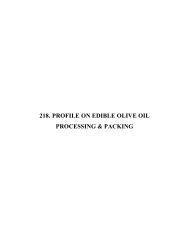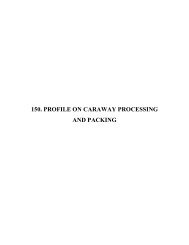profile on production of workers overall and gowns - SNNPR ...
profile on production of workers overall and gowns - SNNPR ...
profile on production of workers overall and gowns - SNNPR ...
You also want an ePaper? Increase the reach of your titles
YUMPU automatically turns print PDFs into web optimized ePapers that Google loves.
248. PROFILE ON PRODUCTION OF WORKERSOVERALL AND GOWNS
248-2TABLE OF CONTENTSPAGEI. SUMMARY 248-3II. PRODUCT DESCRIPTION & APPLICATION 248-3III. MARKET STUDY AND PLANT CAPACITY 248-4A. MARKET STUDY 248-4B. PLANT CAPACITY & PRODUCTION PROGRAMME 248-7IV. RAW MATERIALS AND INPUTS 248-7A. RAW & AUXILIARY MATERIALS 248-7B. UTILITIES 248-8V. TECHNOLOGY & ENGINEERING 248-9A. TECHNOLOGY 248-9B. ENGINEERING 248-10VI. MANPOWER & TRAINING REQUIREMENT 248-12A. MANPOWER REQUIREMENT 248-12B. TRAINING REQUIREMENT 248-12VII. FINANCIAL ANALYSIS 248-14A. TOTAL INITIAL INVESTMENT COST 248-13B. PRODUCTION COST 248-14C. FINANCIAL EVALUATION 248-15D. ECONOMIC BENEFITS 248-16
248-3I. SUMMARYThis <str<strong>on</strong>g>pr<strong>of</strong>ile</str<strong>on</strong>g> envisages the establishment <strong>of</strong> a plant for the producti<strong>on</strong> <strong>of</strong> <strong>workers</strong> <strong>overall</strong><strong>and</strong> gown with a capacity <strong>of</strong> per annum.The present dem<strong>and</strong> for the proposed product is estimated at 11,827 pieces per annum.The dem<strong>and</strong> is expected to reach at 40,830 pieces by the year 2020.The plant will create employment opportunities for 27 pers<strong>on</strong>s.The total investment requirement is estimated at about Birr 3.36 milli<strong>on</strong>, out <strong>of</strong> whichBirr 404,250 is required for plant <strong>and</strong> machinery.The project is financially viable with an internal rate <strong>of</strong> return (IRR) <strong>of</strong> 14 % <strong>and</strong> a netpresent value (NPV) <strong>of</strong> 626,400 discounted at 8.5 %.II.PRODUCT DESCRIPTION & APPLICATIONWorkers <strong>overall</strong> <strong>and</strong> <strong>gowns</strong> is popular am<strong>on</strong>g <strong>workers</strong> engaged in machinery operati<strong>on</strong> oroutdoor work. The market for <strong>workers</strong> <strong>overall</strong> <strong>and</strong> <strong>gowns</strong> grows as the number <strong>of</strong>employees engaged in industry increases .III.MARKET AND PLANT CAPACITYA. MARKET STUDY1. Past Supply <strong>and</strong> Present Dem<strong>and</strong>Workers <strong>overall</strong> <strong>and</strong> gown is popular am<strong>on</strong>g <strong>workers</strong> engaged in machinery operati<strong>on</strong> oroutdoor work. The dem<strong>and</strong> for the product is essentially met from domestic producti<strong>on</strong>.
248-5Table 3.1DISTRIBUTION OF LARGE AND MEDIUM SCALE MANUFACTURINGINDUSTRIES BY REGIONAL STATESRegi<strong>on</strong> Number <strong>of</strong> PercentageEstablishmentsTigray 63 5.22Afar 11 0.91Amhara 125 10.36Oromiya 193 15.99Somalie 8 0.66SNNP 109 9.03Gambella 2 0.17Harari 31 2.57Addis Ababa 626 51.86Dire Dawa 39 3.23Total 1207 100.00Source: CSA, Report <strong>on</strong> Large <strong>and</strong> Medium Scale Manufacturing <strong>and</strong>Electricity Industries Survey, 2006.2. Dem<strong>and</strong> Projecti<strong>on</strong>Workers <strong>overall</strong> <strong>and</strong> <strong>gowns</strong> are widely used by <strong>workers</strong> employed in the manufacturingindustry, which is highly associated with ec<strong>on</strong>omic growth. The c<strong>on</strong>sumpti<strong>on</strong> <strong>of</strong> theproducts is, therefore, influenced by the rate <strong>of</strong> ec<strong>on</strong>omic growth. C<strong>on</strong>sidering the quiteremarkable rate <strong>of</strong> ec<strong>on</strong>omic growth that has been successively registered by the countrysince the recent past <strong>and</strong> the rapidly growing dem<strong>and</strong> for manufactured products, thedem<strong>and</strong> for <strong>workers</strong> <strong>overall</strong> <strong>and</strong> <strong>gowns</strong> is assumed to grow at the rate <strong>of</strong> 10%. Theprojected dem<strong>and</strong> for the product is depicted in Table 3.2.
248-6Table 3.2PROJECTED DEMAND FOR WORKERS OVERALL AND GOWNSProjected Dem<strong>and</strong>Year(Number)2007 11,8272008 13,0102009 14,3112010 15,7422011 17,3162012 19,0482013 20,9522014 23,0472015 25,3522016 27,8872017 30,6762018 33,7442019 37,1182020 40,8302021 44,9132022 49,4043. Pricing <strong>and</strong> Distributi<strong>on</strong>The retail price <strong>of</strong> <strong>workers</strong> <strong>overall</strong> <strong>and</strong> gown is about Birr 150. Allowing margin forretailers <strong>and</strong> wholesalers, the envisaged plant is expected to sell its product at per unitprice <strong>of</strong> Birr 130. The product can get its market outlet through the existing wholesale<strong>and</strong> retail network, which includes department stores, merch<strong>and</strong>ise shops <strong>and</strong>supermarkets. The envisaged plant can also supply its product directly to customers thatinclude firms in the large, medium <strong>and</strong> small scale manufacturing industry.
248-7B. PLANT CAPACITY & PRODUCTION PROGRAMME1. Plant CapacityThe market study for <strong>workers</strong> <strong>overall</strong> <strong>and</strong> gown indicates that the effective dem<strong>and</strong> forthe items is 11,827 pieces in 2007. This figure grows to 25,352 <strong>and</strong> 40,830 pieces in2015 <strong>and</strong> 2020, respectively. Accordingly, c<strong>on</strong>sidering small scale producti<strong>on</strong> <strong>of</strong> thecloth items, the envisaged plant will have annual producti<strong>on</strong> capacity <strong>of</strong> 10,000 <strong>overall</strong>s.The plant will operate single shift 8 hours a day <strong>and</strong> for 300 days a year.2. Producti<strong>on</strong> ProgrammeProducti<strong>on</strong> will start at lower capacity, with the plant operated at 75% capacity during thefirst year <strong>of</strong> operati<strong>on</strong>. Then, producti<strong>on</strong> will grow to 85% <strong>and</strong> 100% <strong>of</strong> plant capacityduring the 2 nd <strong>and</strong> 3 rd year, respectively. Producti<strong>on</strong> build-up is shown in Table 3.3below.Table 3.3PRODUCTION PROGRAMMEYear 1 2 3 <strong>and</strong> aboveCapacity utilizati<strong>on</strong> (%) 75 85 100Producti<strong>on</strong> (PCS) <strong>workers</strong> 7,500 8,500 10,000<strong>overall</strong> /GownIV.MATERIALS AND INPUTSA. RAW MATERIALSThe major raw material required to prepare <strong>workers</strong> <strong>overall</strong> <strong>and</strong> gown is blue jeans cloth<strong>and</strong> should be <strong>of</strong> Denim type. This is <strong>on</strong> account <strong>of</strong> the character <strong>of</strong> working clothes.
248-8The width <strong>of</strong> the cloth can be <strong>of</strong> 92-100 cm <strong>and</strong> 40 metres l<strong>on</strong>g roll. The required clothsize is 92 cm by 4.0 metres. For 10000 <strong>workers</strong> <strong>overall</strong> per annum, <strong>and</strong> c<strong>on</strong>sidering 1%wastage, the raw material requirement will be 40400 metres.The plant requires auxiliary materials such as sewing thread, accessories such as butt<strong>on</strong>s,zippers, sewing needles, clips, scissors, labels, polyethylene sheets <strong>and</strong> packing boxes.Details <strong>of</strong> raw <strong>and</strong> auxiliary materials <strong>and</strong> related annual costs are given in Table 4.1below.Table 4.1RAW AND AUXILIARY MATERIALSSr.Descripti<strong>on</strong> Qty Cost (‘000 Birr)No. LC FC TC1 Blue jeans cloth (m) 40400 198.0 - 198.02 Sewing thread (km) 2720 15.0 - 15.03 Butt<strong>on</strong>s Req 5.0 - 5.04 Zippers Req 5.0 - 5.05 Sewing needles Req 2.0 - 2.06 Clips <strong>and</strong> scissors Req 0.5 - 0.57 Labels Req 0.8 - 0.88 Polyethylene sheets Req 2.0 - 2.09 Packing boxes (cart<strong>on</strong>s) Req 10.0 - 10.0Total - 238.30 - 238.30B. UTILITIESElectricity, fuel oil <strong>and</strong> water are utilities required by the plant. Electricity is required forprime movers, for lighting <strong>and</strong> power sockets.
248-9Fuel oil is used for steam generati<strong>on</strong> (firing a boiler) for pressing <strong>workers</strong> cloth. Water isrequired for drinking, general purpose <strong>and</strong> for c<strong>on</strong>versi<strong>on</strong> into steam. Annualrequirement <strong>of</strong> utilities at full capacity producti<strong>on</strong> is shown in Table 4.2 below.Table 4.2ANNUAL REQUIREMENT OF UTILITIESSr.Descripti<strong>on</strong> Qty Cost (‘000 Birr)No.1 Electricity (kWh) 15,000 7.112 Water (m 3 ) 2500 25.03 Fuel oil (litres) 6000 32.46Total - 64.57V. TECHNOLOGY AND ENGINEERINGA. TECHNOLOGY1. Producti<strong>on</strong> ProcessThe major operati<strong>on</strong>s involved in the manufacturing <strong>of</strong> <strong>workers</strong> <strong>overall</strong> gown are thefollowing:-a) Pattern design <strong>and</strong> patternmaking; pattern making process by h<strong>and</strong> work.b) Cloth cutting, grading process by mechanical cutting system <strong>and</strong> piecebundling.c) Sewing by high speed industrial sewing machine.d) Trimming <strong>and</strong> inspecti<strong>on</strong>e) Ir<strong>on</strong>ing <strong>and</strong> pressing for finishing processf) Packing <strong>and</strong> delivery.
248-102. Source <strong>of</strong> TechnologyAddress <strong>of</strong> a German company that supplies machinery for <strong>workers</strong> over all <strong>and</strong> gownproducti<strong>on</strong> is given below:G.M. PFAFF A.GP.O.Box 3020D- 67653 KaiserslauterGERMANYFax: (0631) 17202B. ENGINEERING1. Machinery <strong>and</strong> EquipmentThe plant requires installati<strong>on</strong> <strong>of</strong> <strong>on</strong>e line <strong>of</strong> producti<strong>on</strong> for <strong>workers</strong> <strong>overall</strong> <strong>and</strong> gown.The details <strong>of</strong> the required plant equipment <strong>and</strong> related costs are shown in Table 5.1below.
248-11Table 6.1LIST OF MACHINERY AND EQUIPMENTSr.Descripti<strong>on</strong> Qty Cost (‘000 Birr)No. LC FC TC1 Single needle lock stitch 12 - 60 602 3 – needle chain 2 - 22 223 Chain stitch butt<strong>on</strong> sewing 1 - 17.0 17.04 Lock stitch bar tacker 1 - 28 285 Other special type 1 - 25 256 Steam generator (Boiler) 1 - 175 1757 Steam press (general use type) 2 - 4.0 4.08 Cloth laying machine 1 - 2.5 2.59 B<strong>and</strong> knife cutter 1 - 2 210 Die cutter 1 - 2 211 Clothe ir<strong>on</strong> 4 - 0.5 0.512 Straight knife cutter 2 - 1.2 1.213 Cloth laying <strong>and</strong> cutting table 2 - 0.75 0.7514 Cloth cutting table 2 - 0.8 0.815 Knife sharpener 1 - 0.5 0.516 Material boxes & chutes Req - 3.0 3.017 Shelves & working chairs Req - 7.0 7.018 Air compressor 1 - 5.0 5.019 Air cleaning equipment Unit - 3.0 3.0FOB price 359.25 359.25Freight, insurance, customs & - 45 - 45Bank charges, material h<strong>and</strong>lingcostCIF L<strong>and</strong>ed Cost 45 359.25 404.252. L<strong>and</strong>, Building <strong>and</strong> Civil WorksThe required flour area for the main producti<strong>on</strong> hall for the cutting, sewing, patterndesign <strong>and</strong> sample making, storage <strong>of</strong> material cloth <strong>and</strong> final products, <strong>of</strong>fices <strong>and</strong> showroom, boiler room, air c<strong>on</strong>diti<strong>on</strong>ing unit, finishing secti<strong>on</strong>s including packing <strong>and</strong>delivery room is estimated 1,000 m 2 . Accordingly, the total plant site area required isestimated 2,000 m 2 . This will give opportunity to carry out expansi<strong>on</strong> work <strong>and</strong> haveaccess to internal path ways.
248-12At an average l<strong>and</strong> lease rate <strong>of</strong> Birr 1.0 per m 2 , <strong>and</strong> unit building cost <strong>of</strong> Birr 2,000 (perm 2 ), the l<strong>and</strong> lease value for a period <strong>of</strong> 80 years will be Birr 160,000, <strong>and</strong> total buildingcost <strong>of</strong> Birr 2 milli<strong>on</strong>. Thus, the total initial investment <strong>on</strong> l<strong>and</strong>, building <strong>and</strong> civil worksis estimated to be Birr 2.16 milli<strong>on</strong>.3. Proposed Locati<strong>on</strong>Locati<strong>on</strong> <strong>of</strong> a plant is determined <strong>on</strong> the basis <strong>of</strong> proximity <strong>of</strong> raw materials, availability<strong>of</strong> infrastructure <strong>and</strong> distance <strong>of</strong> potential market outlets. Three woredas, namelyArbaminch Zuria, Awassa Zuria <strong>and</strong> W<strong>on</strong>ago are identified. C<strong>on</strong>sidering fair distributi<strong>on</strong><strong>of</strong> projects am<strong>on</strong>g <strong>SNNPR</strong>S Woredas, Awassa zurea is selected. The envisaged plantwill therefore be established in Awassa town.VI.MANPOWER AND TRAINING REQUIREMENTA. MANPOWER REQUIREMENTThe garment plant requires direct producti<strong>on</strong> <strong>workers</strong> <strong>and</strong> administrati<strong>on</strong> staff. Details <strong>of</strong>manpower requirement <strong>and</strong> estimate <strong>of</strong> annual expenditure <strong>on</strong> manpower is given inTable 6.1 below.B. TRAINING REQUIREMENTWorkers directly related to producti<strong>on</strong> will be given two weeks training in <strong>on</strong>e <strong>of</strong> thegarment factories in Addis Ababa. A total <strong>of</strong> Birr 10,000 is allotted to execute thetraining programme.
248-13Table 6.1MANPOWER REQUIREMENTSr.Job Title Nos. M<strong>on</strong>thly Annual WagesNo.SalaryA. Administrati<strong>on</strong>1 Plant manager 1 2,000 24,0002 Secretary 1 600 7,2003 Store man 1 700 8,4004 Cashier 1 500 6,0005 Clerk 1 375 4,5006 General services 2 250 6,000Sub-total 7 - 56,100B. Producti<strong>on</strong>1 Skilled <strong>workers</strong> 15 600 108,0002 Unskilled 4 250 12,000Sub total 20 - 129,600Workers benefit (25% BS) - 46,425Total 27 233,925VII. FINANCIAL ANALYSISThe financial analysis <strong>of</strong> the <strong>workers</strong> <strong>overall</strong> <strong>and</strong> <strong>gowns</strong>presented in the previous chapters <strong>and</strong> the following assumpti<strong>on</strong>s:-project is based <strong>on</strong> the dataC<strong>on</strong>structi<strong>on</strong> period3 yearsSource <strong>of</strong> finance% equity% loanTax holidays3 yearsBank interest 70 %
248-14Discount cash flow 30%Accounts receivable30 daysRaw material local30 daysWork in progress2 daysFinished products30 daysCash in h<strong>and</strong>10 daysAccounts payable30 daysA. TOTAL INITIAL INVESTMENT COSTThe total investment cost <strong>of</strong> the project including working capital is estimated at Birr3.36 milli<strong>on</strong>, <strong>of</strong> which 36 per cent will be required in foreign currency.The majorbreakdown <strong>of</strong> the total initial investment cost is shown in Table 7.1.Table 7.1INITIAL INVESTMENT COSTSr.Total CostNo. Cost Items (‘000 Birr)1 L<strong>and</strong> lease value 1602 Building <strong>and</strong> Civil Work 2,160.003 Plant Machinery <strong>and</strong> Equipment 404.254 Office Furniture <strong>and</strong> Equipment 755 Vehicle 2006 Pre-producti<strong>on</strong> Expenditure* 302.237 Working Capital 63.55Total Investment cost 3,365.0Foreign Share 36* N.B Pre-producti<strong>on</strong> expenditure includes interest during c<strong>on</strong>structi<strong>on</strong> (Birr 202.23thous<strong>and</strong>) training (Birr 10 thous<strong>and</strong>) <strong>and</strong> Birr 90 thous<strong>and</strong> costs <strong>of</strong> registrati<strong>on</strong>,licensing <strong>and</strong> formati<strong>on</strong> <strong>of</strong> the company including legal fees, commissi<strong>on</strong>ing expenses,etc.
248-15B. PRODUCTION COSTThe annual producti<strong>on</strong> cost at full operati<strong>on</strong> capacity is estimated at Birr 1.07 milli<strong>on</strong>(see Table 7.2). The material <strong>and</strong> utility cost accounts for 28.19 per cent, while repair<strong>and</strong> maintenance take 6.98 per cent <strong>of</strong> the producti<strong>on</strong> cost.Table 7.2ANNUAL PRODUCTION COST AT FULL CAPACITY ('000 BIRR)Items Cost %Raw Material <strong>and</strong> Inputs238.30 22.18Utilities64.57 6.01Maintenance <strong>and</strong> repair75 6.98Labour direct140.35 13.06Factory overheads58.48 5.44Administrati<strong>on</strong> Costs93.57 8.71Total Operating Costs670.27 62.38Depreciati<strong>on</strong>215.93 20.10Cost <strong>of</strong> Finance188.22 17.52Total Producti<strong>on</strong> Cost1,074.42 100C. FINANCIAL EVALUATION1. Pr<strong>of</strong>itabilityAccording to the projected income statement, the project will start generating pr<strong>of</strong>it in thefirst year <strong>of</strong> operati<strong>on</strong>. Important ratios such as pr<strong>of</strong>it to total sales, net pr<strong>of</strong>it to equity(Return <strong>on</strong> equity) <strong>and</strong> net pr<strong>of</strong>it plus interest <strong>on</strong> total investment (return <strong>on</strong> totalinvestment) show an increasing trend during the life-time <strong>of</strong> the project.
248-16The income statement <strong>and</strong> the other indicators <strong>of</strong> pr<strong>of</strong>itability show that the project isviable.2. Break-even AnalysisThe break-even point <strong>of</strong> the project including cost <strong>of</strong> finance when it starts to operate atfull capacity (year ) is estimated by using income statement projecti<strong>on</strong>.BE = Fixed Cost = 34 %Sales – Variable Cost3. Pay Back PeriodThe investment cost <strong>and</strong> income statement projecti<strong>on</strong> are used to project the pay-backperiod. The project’s initial investment will be fully recovered within 6 years.4. Internal Rate <strong>of</strong> Return <strong>and</strong> Net Present ValueBased <strong>on</strong> the cash flow statement, the calculated IRR <strong>of</strong> the project is 14 % <strong>and</strong> the netpresent value at 8.5 % discount rate is Birr 626,400.D. ECONOMIC BENEFITSThe project can create employment for 27 pers<strong>on</strong>s. In additi<strong>on</strong> to supply <strong>of</strong> the domesticneeds, the project will generate Birr 789,580 in terms <strong>of</strong> tax revenue. The establishment<strong>of</strong> such factory will have a foreign exchange saving effect to the country by substitutingthe current imports.


